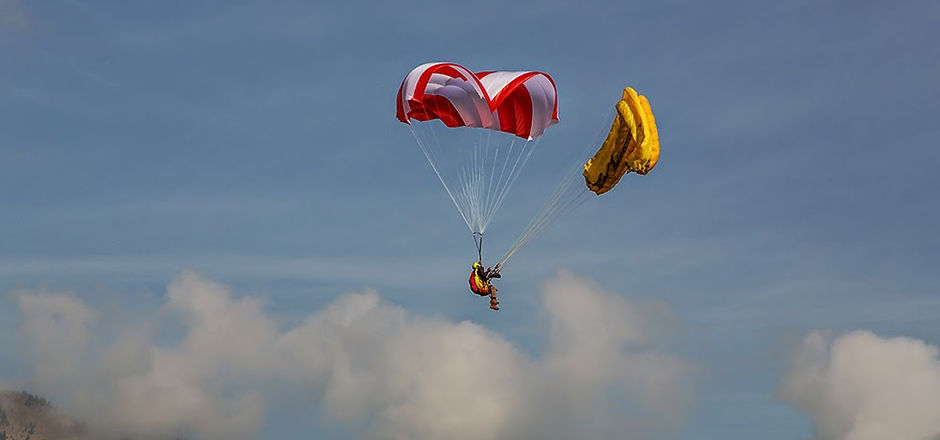
INTRODUCTORY VIDEO
Watch the following video before your first day at the Ranch
This video reviews all the basics you'll need to know for your first day. Watching this prior to arriving ensures you will be up in the air as soon as possible! Watching multiple times is even better.
Aerodynamics
Why does the wing fly??
Here's a great 15 minutes video that will show you what is currently understood about Aerodynamic Lift.
EQUIPMENT
How to choose your gear.

HARNESS
Keeps you attached to the wing!
Your harness is probably the most important piece of paragliding equipment. Almost all the information that your glider gives you about the air is received through your harness. It’s where the body integrates with your flying contraption, and if it isn’t comfortable, you won’t be having a good time.
The first question when looking at harnesses is the style, light weight for hiking and traveling or something with maximum back protection and durability. You can get more information from your instructors and other pilots, as well as looking around online, to help you with this decision.
Most shops won’t let you fly it before you buy it, but they should have a simulator you can hang it in. Size charts only account for overall height, but your torso versus leg length can drastically change the sizing. So ideally, you can try a couple sizes. Make sure the harness supports your back and your legs. Take the time to sit in them awhile, play with the adjustments, and make sure it’s just right.

RESERVE PARACHUTES
Your Plan B
Many experienced pilots fly for 20+ years without ever needing to throw their reserve parachute- but the one time you do throw it, you definitely want it to work without a hitch!
Selection of your reserve will mostly boil down to your “all up weight” (Your weight plus weight of your kit) and then how much money you want to spend. Generally, the lighter the weight the higher the price. The current price point models are a good balance of wight, cost and performance (decent rate), so most students go with this option.
You want to be below the maximum weight limit of the reserve parachute, and above the minimum, if there is one. There’s a bit of a trade off with reserve chutes in regards to weight. The heavier you are, the faster you’re going to come down, but there could be a slightly faster opening time. Conversely, the lighter you are on a reserve, the slower you’ll come down, but there is potential for a slower opening time.

PARAGLIDER
The aircraft that fits into a backpack
There are big differences how paragliders handle between companies and between the models. For a new glider it's easy, have your instructor help you pick out a glider that will best suit you and the type of flying you think you’ll be doing.
If you decided to go used, you should still have your instructor help you pick something you’re going to like, but here are some things to check out when looking at used gliders.
Is the glider appropriate for my skill level?
Most paragliders will carry a certification from a European testing center. The most common up until recently was DHV, however now you’ll see more and more LTF and EN as certifications.The gliders are flown through a series of tests to determine how they behave under different and sometimes adverse flying conditions. The result is a number or letter corresponding to the gliders characteristics, which gives us an idea of what type of pilot the glider is best suited towards.
As a newer pilot it’s best to stay in the DHV/LTF 1 or EN A category. These gliders will give a newer pilot all the performance and handling they’re capable of utilizing, plus keep you feeling safe and comfortable while you get your first year or two of flying under your belt. Getting a higher performance glider will do nothing for a newer pilot, and likely cause them more difficulties.
How old is it?
Gliders have come a long way in safety, performance, materials and construction over the years. We recommend avoiding gliders over 10 years old, with some exceptions.
Has it been inspected recently?
It’s not rude or unacceptable to request that a glider you wish to purchase be inspected. Most serious sellers should expect it, and an inspection costs about $175. An inspection will check out the fabric for porosity (how fast does air pass through the fabric), fabric tear strength, and a line strength test of one of the center A lines (most load bearing). Each of these tests has a standard the glider must pass for the it to be considered air worthy. If the paraglider passes all the tests, a number will be assigned that designates approximately how much life the glider should have left in it.
Repairs:
Repairs are not as big a deal as you might think. Gliders end up getting small holes or tears in them along the way, but fortunately they can be easily sewn, sometimes taped (if the hole is small enough), and be just fine. Just make sure if the glider has had a major repair that it was done professionally.
Lastly, don’t be in a big hurry to purchase your equipment before you have had at least a lesson or two. Most of the bigger schools will provide equipment for your first flights so it’s not necessary to show up with your own gear, and this will give you the chance to ask questions. Your idea’s about what is possible with paragliding and what you want out of the sport may change after your first lesson, so do some research and go to your instructor armed with good questions and ready for a life changing experience.
